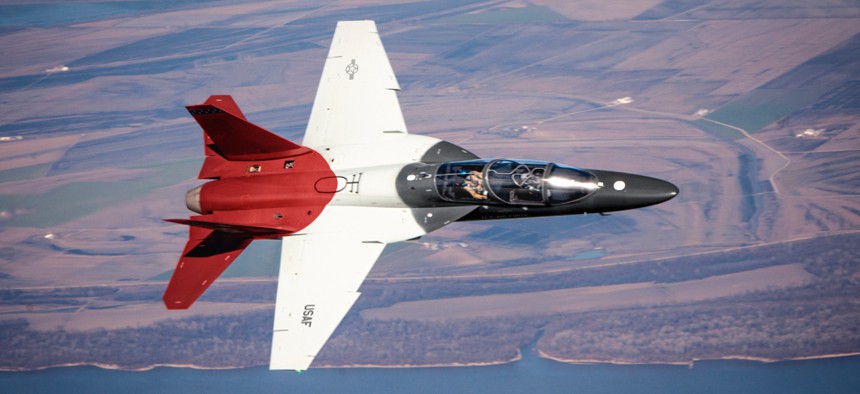
A Boeing T-7A Red Hawk jet on a test flight. Boeing
Who is Secretly Building the USAF’s New Fighter?
Officials are mum, so here’s a roundup of clues.
Among the big questions surrounding the secret U.S. Air Force fighter-jet demonstrator revealed this week is: who built it?
Will Roper, the head of Air Force acquisition, declined to say much about the new plane, other than it has actually flown, that some of the plane’s systems have been flight-tested, and that it was designed and built using digital engineering.
So let’s look at some clues, starting with a likely predecessor to the Next Generation Air Dominance project that produced the new demonstrator.
In January 2015, Frank Kendall, then defense undersecretary for acquisition, technology and logistics, told the House Armed Services Committee about a DARPA-led project that was developing new planes and engine technology for the Air Force and Navy.
“The intent is to develop prototypes for the next generation of air-dominance platforms — X-plane programs, if you will," Kendall said.
Dubbed the Aerospace Innovation Initiative, the project aimed to “develop the technologies and address the risks associated with the air dominance platforms that will follow the F-35, as well as other advanced aeronautical challenges.”
Roper wouldn’t say whether the NGAD and AII projects are linked, but they sound quite similar. He instead said that he disclosed the plane’s existence, in part, to encourage companies to invest more in digital engineering.
"The obvious candidates for the NGAD prototype are Boeing, Lockheed Martin and Northrop Grumman, though General Atomics might be a possible designer—but that’s a long-shot," Byron Callan, an analyst with Capital Alpha Partners, wrote in a Tuesday note to clients. "Textron’s Scorpion program had recently proven that in one year’s time, it could take a new clean sheet design to flight, but we doubt it’s been able to elevate this skill to combat aircraft."
The plane's engine, Callan wrote, was built by either GE or Raytheon Technologies' Pratt & Whitney.
Here’s the case for why each of the following companies could have built the new NGAD fighter.
Boeing
The Chicago-based aerospace giant already knows a lot about digital engineering, having partnered with Sweden’s Saab to design and build their T-7A training jet in less than a year, near-lightspeed by U.S. military standards. Air Force officials have gushed about the T-7A, which beat out two other planes, the Lockheed Martin T-50 and Leonardo T-100, that were already being used by foreign air forces. The Boeing plane has a mission computer that can run third-party software and apps, allowing for easy updates. It is also designed for quick assembly: it takes just 15 minutes to assemble the forward and aft fuselages, compared with some 24 hours to assemble a F/A-18 Super Hornet fuselage, according to Leanne Caret, the CEO of Boeing Defense.
Northrop Grumman
It often gets overlooked that Northrop owns Scaled Composites — the Burt Rutan-founded, XPrize-winning design shop behind SpaceShipOne, the first aircraft to carry private citizens into space. Like Boeing, Northrop’s Scaled built a plane from scratch for the Air Force’s pilot training jet contest, but in the end didn’t submit a bid.
Northrop has seen an uptick in classified Pentagon work in recent years. It’s been presumed that a sizable portion of that cash has gone to build B-21 stealth bombers, whose existence has been disclosed but are being built in secret. It’s conceivable that some of the classified cash flowing into the company’s Aeronautical Systems business is for the NGAD test aircraft.
Northrop is also building the Ground Based Strategic Deterrent, the new intercontinental ballistic missiles that will replace the Cold War Minuteman III, using the same digital design technology often touted by Roper.
Lockheed Martin
The company’s Advanced Development Programs division — far better known as the Skunk Works — has long developed super-advanced, super-secret planes for the U.S. military, including the famed U-2 and SR-71 spy planes and the F-117 ground-attack jet. They also built the F-22 Raptor and F-35 Joint Strike Fighter.
“ADP seems pretty busy across a number of fronts, but also...looking at the Digital Century Series and also looking at where the services are going to go in terms of sixth-gen and next-gen aircraft,” said Michele Evans, who leads Lockheed Martin Aeronautics and its Skunk Works operation, last week.
Evans also touted Stardrive, a Lockheed effort to incorporate more commercial technology and practices into its manufacturing.
“Think of model-based systems engineering, think about factory of the future, software development in terms of containerization technologies like Kubernetes, and agile [software] and then even into sustainment in terms of how we use data analytics and AI,” she said. “I think the technologies are just going to provide tremendous opportunities to speed up the development in the delivery of platforms going forward.”
Someone else
The most intriguing possibility is that the new jet may not be the product of one of the defense giants at all. There is evidence that the digital-design tools that Roper touted are allowing smaller upstarts to enter markets once reserved for only a few established contractors. In July, for example, an Air Force solicitation for proposals for drones to accompany manned jets drew 18 entries.
“It shows there’s a lot of interest from very large [companies], which you would expect, to very small,” Gen. Arnold Bunch, the head of Air Force Materiel Command, said in a Wednesday videoconference call with reporters. “I actually believe as we do the digital campaign and we look at doing digital engineering, it will actually open the door to more people to be able to participate that may not have before.”




